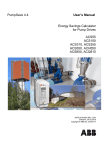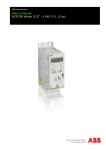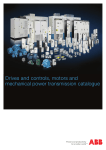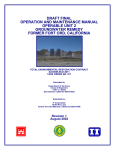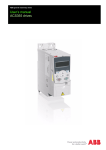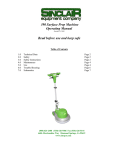Download FanSave 4.4 User`s Manual Energy Savings Calculator for Fan
Transcript
FanSave 4.4 User’s Manual Energy Savings Calculator for Fan Drives ACS55 ACS150 ACS310, ACS355 ACS550, ACH550 ACS800 3AFE 64232681 REV J EN Effective: 24.03.2010 Copyright © ABB Oy, Drives/TT 1 — General FanSave is a calculation tool running on Microsoft Excel to calculate the energy savings available when using a variable speed AC drive (frequency converter) compared to other fan control systems. Comparisons can be made with damper control, pitch control, single speed vane control and 2-speed vane control. Calculations are based on typical fan operating characteristics. Consequently, the accuracy of the results is limited. The accuracy of the results is also affected by the accuracy of the input data. Results should be used only for estimating purposes. The results of this program must not be used as the basis for guaranteed energy savings. Results of calculations can be printed out. Version 4.4 First multi language revision. ACS355 added. Version 4.3 Added the possibility to translate FanSave to languages. Version 4.2 The tables of ABB Drives have been updated for ACS550, ACH550 and new drives added AC310 and minor changes done for look and feel. Also a small change written for 2-speed motor. Version 4.1 The tables of ABB Drives have been updated and user manual corrected to the level of current PumpSave. PumpSave 4.0 did not have a valid user manual. Most data fields are populated with default values to help users. Fan type can be selected. The options are centrifugal and axial flow. If the user selected centrifugal fan type, impeller type can be selected. The options for impeller type are forward curved, backward curved, and radial blades. Supply voltage was called Motor voltage in version 3.1. Version 3.1 The possibility of using US measurement units has been added. The AC drive types available in the North American market have been added. The term “CO2 emissions” is used instead of “GHG emissions” in version 3.1. 2 2 — Starting and Running the Program Software Required Microsoft® Excel 97 or later is required to run the energy calculation workbook. With Microsoft® Office Excel 2007 the workbook runs on compatibility mode. Also you shall enable the running of macros. Files Provided The FanSave files for fan drive calculations are incorporated into Excel workbook named originally FanSave44.xls. Installation No installation is required but the workbook is can be copied to a hard disk and short-cut arranged to desktop. Opening the Workbook Start Excel as usual. For fan calculations open FanSave44.xls. Sometimes it will open in Full Screen mode. Hence, the usual Excel toolbars are not visible. Full Screen mode can be disabled and enabled by selecting Full Screen from the View menu. With Excel 2007 the hitting the Ecs will open the ribbon. As FanSave is opened, a welcome window is displayed. Figure 1 shows the welcome window for FanSave. The welcome sheet presents four comparative calculation options. Click Continue to close the window. Figure 1 Welcoming window of FanSave Then also a long license agreement text is shown. 3 Worksheet After having clicked Continue button and accepting the license terms, the worksheet will open, see Figure 2, where input data is entered and results are presented. The language setting is on top right corner. The translated words and help texts are taken from Language sheet based on English keywords. This manual explains the English ones. There are four buttons in the center of the sheet, Auto-Adjust screen size screen button, Send to default printer button, Save calculation button and Close program button. FanSave is optimized for desktop area of 1600*1200 pixels. If the FanSave view is not fully visible, click the Auto-Adjust screen size button. This zooms 4 the screen so that it should fit into the visible area. It is also possible to zoom the sheet by selecting View – Zoom from Excel menu bar. To exit the program, click the Close program button, or, click the cross button in the upper right corner of the screen. Then Excel will prompt to save the workbook. Also you can save a copy of worksheet to a hard disk by selecting File- Save as from Excel menu bar and save the calculations and give it a different name. Click the Send to default printer button. The sheet can also be printed by selecting File and Print from the Excel menus. 5 3 — FanSave worksheet inputs and results General All white cells on the worksheet are for entering information and data. Please use for decimal symbol either comma or decimal point etc according you Excel settings. The sheet is filled in by default values to help users to right away find the idea of worksheet. Results are displayed on pale yellow background. Figure 2 shows a default worksheet. Figure 2 FanSave view Input data The input data includes information about fan, transmission, existing control method, motor, operating profile. Economic data such as energy price and investment cost is required in order to get figures for investment appraisal. Fan data Fan type Fan type can be selected. The options are centrifugal and axial flow. If the user selected centrifugal fan type, impeller type can be selected. The options for impeller type are forward curved, backward curved, and radial blades. 6 Centifugal fans with reasonable low pressure gas can be computed with FanSave. The computing of high pressure fans does not come correct because the compression of the gas can not be simply modeled. Impeller type Centrifugal fans of different blade shapes behave differently. pmax b) p2 SYSTEM CURVE PtF a) FAN CURVE Q V2 Q VN Graph.1. An example of typical fan and system curves. Nominal Volume Flow, Qvn (m 3/s) Enter the maximum system volume flow in cubic meters per second, which the existing system will deliver and fan must reach with existing control. FanSave will assume that exactly the same flow has to be delivered also with AC Drive. The energy saving calculations will be based on flow rates that are equal to or less than Qvn. Pressure Increase, ptF (Pa) Required pressure increase of the fan for the given nominal volume flow Qvn. Value is determined from the fan curves and system curve intersection. If pressure is more than 5000 Pa FanSave will indicate this by red color and It is better to compute these case manually. Efficiency, (%) Enter the nominal efficiency of the fan at nominal volume flow. Transmission Efficiency, (%) Efficiency of the transmission method e.g. belt transmission. If the fan has been connected directly to the motor, use 100%. Existing Flow Control Pick the existing control method that you want to compare with ABB AC Drive control. The control method is selected from the drop-down list on the upper left part of the sheet. The control options are: Outlet damper, Slip coupling, Voltage,Two-speed motor, Cyclic (on/off), Inlet box damper, Inlet vanes, ( 1-speed vane, 2-speed vane and Pitch control). The smaller energy usage of frequency converter is compared to a large energy required by: 7 Outlet damper control which control the volume flow by throttling it with a damper. Slip coupling which control the fan speed with slippage by hydraulic/eddy current technology. Voltage control which will make the motor voltage lower and make the induction motor to have larger slip. Note! Voltage control is applicable only for fans with lower unit powers (< 3kW) Two speed motor (two sets of windings 1:2/Dahlander connection) which means larger motor compared to one speed motor. Cyclic (on/off) which means ON/OFF duty is adjusted according to flow requirements and it is acceptable from application point of view. The control can’t be as good as with speed control. When motor and fan are running they run at full speed. Inlet box damper is based on damper control. Pitch adjustment for axial fans / Inlet vanes for centrifugal fans Vane control is done by inlet vane installed at the fan inlet. Pitch control is by adjusting the pitch angle of axial-flow fan. Motor data FanSave is computing from pump data the required motor output power including 10% thermal margin. Based on this number you may enter the Motor power. Motor power (kW) Enter the nameplate power rating of the motor. This is used to select the proper drive rating. The program uses calculated power demand to determine energy savings. Supply Voltage (V) Enter the supply voltage used in application. The value should be between 115 (1-ph) to 690 V (3-ph). This is used to screen out some drive types. Motor efficiency, m (%) Enter the motor efficiency from the motor nameplate or from other data supplied by the motor manufacturer. Use the efficiency for full load operation on fixed frequency utility power. The program will adjust the efficiency for operation at reduced speeds and loads. If the motor is oversized for the application, enter the efficiency for operation at the maximum applied load. Operating profile Annual running time In other words, this is the total operating time per year. Enter the estimated number of hours that the fan is expected to run during a year’s time. For 24 hour, 365-day operation, enter 8760 hours. Operating Time at Different Flow Rates (%) Enter the estimated time as a percentage of the total operating time for operation at each of the listed flow rates from 100% to 20% of nominal volume flow. Leave blank or enter zero for flow rates that are not used. The sum of the entered percentages should be 100%. A figure under the white cells shows if the sum equals 100. If it does not, a comment “THIS SUM MUST EQUAL 100!” shows. 8 Drive data User should select the drive family from drop down box. FanSave will pick the drive rating based on motor power and voltage. Economic Data Currency Specify here the currency to be used in calculations. The default unit is the Euro (EUR). Energy price (per kWh) Enter the price of energy per kilowatt-hour (kWh). The FanSave program does not have provisions for calculating demand charges. To estimate energy cost including demand charges, enter the average cost of energy per kWh including average demand charges. Investment Cost Enter the estimated additional cost of purchasing and installing a variable speed AC drive as compared to the alternative method of flow control used in the comparison. Use the same currency units as entered for energy cost. This entry will be used to calculate the direct payback time. Interest Rate (%) This figure is the compensation of capital that is used in net present value calculation. Service Life (years) The expected service life of the drive. Also this is required for the net present value calculation. 9 Results The results of the calculations include the estimated annual energy consumption for the existing control method and for AC drive control, the difference of these two, which equals the annual energy saving achieved by using a variable speed AC drive. FanSave also estimates the reduction in carbon dioxide (CO2) emissions due to the reduced electricity consumption. CO2 is the most important of the greenhouse gases, which cause a global environmental problem called the climate change. Payback period is calculated for the investment in the drive as compared to the alternative method of flow control. Net present value is also calculated provided that the user enters an interest rate and service life. Energy & environmental Electric power consumption of fan – graph (kW) The calculated power used with the existing control method and using a frequency converter are both illustrated xy-chart. Electric power consumption of fan 40.0Inlet vanes A C drive co ntro l 35.0 30.0 kW 25.0 20.0 15.0 10.0 5.0 0.0 2 3 4 5 6 7 8 9 10 Air f low r at e Saving percentage % The reduction in electricity costs in percents. This is also, of course, the energy saving in percents. Annual energy consumption (kWh) These are shown for both with existing control method and improved control method. Annual energy saving (kWh) This is the energy difference in favor of frequency converter control. Annual CO2 reduction (kg) The reduction in carbon dioxide (CO2 ), which results from the reduced energy consumption due to variable speed control. Carbon dioxide CO 2 is the primary greenhouse gas causing global warming. The CO2 reduction depends on the CO 2 emission per unit, which should reflect the way and emissions the electricity used has been generated with. The 10 per unit emission is given in kg/kWh consumed, and it can be altered by the user. Economic results Annual money saving This is how much money you save thanks to the variable speed control by AC drive. Money saving comes in the form of smaller electricity bill. Payback period This direct payback time shows how many years the investment has paid itself back. Net present value Net present value (NPV) is a more advanced method for analyzing investments than the payback period rule. If the NPV is positive, then the investment should be accepted. Additional data Gas Density, D (kg/m 3) The normal air density is 1,20kg/m3. For other temperatures and humidities use available monographs to find out the correct density or calculate it using the following formula. This can be used if fan curves are given with some data and the gas in question is somewhat different. Table 1 gives air densities for temperatures from 0 to 450 C. T p D1 Dx x sa1 , where T1 psa 2 D1 = required density Dx = known density T1 = temperature at required density Tx = known temperature Psa1 = pressure at required density Psa2 = known pressure 11 Table 1 Density of dry air as function of temperature at normal air pressure 1013 mbar Temperature C 0 10 20 30 40 50 60 70 80 90 100 120 140 160 180 200 250 300 350 400 450 Density 3 kg/m 1.2930 1.2471 1.2045 1.1647 1.1267 1.0924 1.0595 1.0287 0.9998 0.9719 0.9458 0.8980 0.8535 0.8150 0.7785 0.7457 0.6745 0.6157 0.5662 0.5242 0.4875 12 4 — FanSave worksheet with US units Input Data with US Units The initial data presented in the following consists of the same elements as above but is entered using US measurement units. The following applies when “US Units” is selected. . In the following the changes to non-SI are only explained. Figure 3 FanSave view with US units Fan data Nominal Volume Flow, Qvn (cfm) Motor Data Motor Power (Nominal Power), P (Hp) Results Annual CO2 Reduction (lb) 13 5 — Explanation of Calculations Fan performance curves Fan performance can be defined from its performance curves i.e. pressure curve (Qv/ptF-curve) and power curve (Qv/P R-curve). Different fan types have different shaped performance curves. Additionally, the position of the curves depends on gas density and rotation speed. For these reasons, the performance curves are often presented as sets of curves with different parameters. The manufacturer of the fan provides these performance diagrams. The pressure curve of the fan can also be referred to as the fan curve. The suitability of a fan to a certain duct system depends partly on the form of the fan curve. All the calculations of FanSave are based on parabolic fan curve. The useful mechanical power transferred into the volume flow is called air power P F. It is proportional to the gas volume flow, compression factor and total fan pressure. For low pressure fans the compression factor 1. The impeller power PR (also called shaft power), i.e. the mechanical power necessary for rotating the fan is then obtained by taking the fan efficiency into account. For all centrifugal fans the impeller power increases as the volume increases. This connection is presented in the power curve of the fan. Further on, the electric fan power is calculated by taking the motor and drive efficiencies into account. System curve All the duct systems have their special performance curve, system curve, dependent on the resistances in the duct. In a turbulent flow, all the resistances caused either by friction or various duct elements are proportional to the square of the volume flow. From this follows that the resistance of the duct system, i.e. system curve, often complies with the same rule. Especially in industrial processes it is likely to encounter also system curves with an additional constant pressure and previously mentioned changing pressure. The calculations of FanSave are based and valid on the basic system curve without any constant pressure. When adjusting the fan speed to control the volume flow, the process moves via system curve (a). Respectively, when throttling the duct the fan operates continuously at the same speed, and the movement of the process is via fan curve (b). 14 Control methods For FanSave calculations the most important control methods to control the fans during operation have been selected. Fig.4 below shows the relationship of the electric fan power compared to the volume flow in connection with these control methods. The control method presentations are average examples used in calculations. Figure 4 The power curves of flow control methods. Efficiencies The given values are used in the formulas. Further, as shown in the formulas, the efficiency of the system depends on the given efficiencies of fan, mechanical transmission, motor and drive, and on the adjustment method specific correcting factor. These correcting factors have been derived empirically. 15 FanSave calculations The following formulas are used for power calculations: The impeller power i.e. nominal shaft power of a fan is calculated from the formula Pf kp Qvn ptF where kp is compression factor kp 1 0.35 ptF nk pta The electrical power for different control methods, and for different flow rates is calculated as follows. Frequency converter control nominal power Pf Pvs100 , where nk nt nm nd where nk =fan efficiency nt = transmission efficiency nm= motor efficiency nd=drive efficiency The power consumption on lower flow levels are tabulated Flow 0.2 0.3 0.4 0.5 0.6 0.7 0.8 0.9 Multiplier 0.035 0.055 0.095 0.155 0.24 0.37 0.515 0.74 Other control types Pf nk nt nm Pd 100 where nk =fan efficiency nt = transmission efficiency nm= motor efficiency 16 The power consumption on lower flow levels are tabulated with following multipliers. Slip Voltage Flow 0.2 0.3 0.4 0.5 0.6 0.7 0.8 0.9 0.146 0.163 0.22 0.297 0.386 0.505 0.626 0.773 0.094 0.156 0.223 0.331 0.44 0.563 0.703 0.846 Flow 0.2 0.3 0.4 0.5 0.6 0.7 0.8 0.9 Outlet damper F 0.38 0.38 0.395 0.45 0.525 0.615 0.715 0.84 Outlet damper B 0.49 0.57 0.655 0.723 0.79 0.855 0.91 0.96 Two speed 0.225 0.225 0.225 0.225 0.225 1 1 1 Cycli c 0.2 0.3 0.4 0.5 0.6 0.7 0.8 0.9 Inlet damper 0.47 0.5 0.54 0.58 0.62 0.67 0.75 0.84 Pitch 0.339 0.36 0.394 0.446 0.483 0.559 0.636 0.763 Inlet vanes 0.339 0.36 0.394 0.446 0.483 0.559 0.636 0.763 Outlet damper R 0.49 0.57 0.655 0.723 0.79 0.855 0.91 0.96 Unit Conversions The formulas above use metric measurement units. In the case US units have been selected to be used in entering the data and presenting the results, the following conversion factors have been used: Nominal volume flow Pressure increase Inlet Static Pressure Nominal Power Mass (weight) Qvn: p tF: pta: P: [cfm]/2118.88=[ m³/s] [in-H2O]*249.08194 =[Pa] [psi]* 6894.7573=[Pa] [Hp]* 0.7457=[kW] [lb]*0.4536=[kg] 17

















